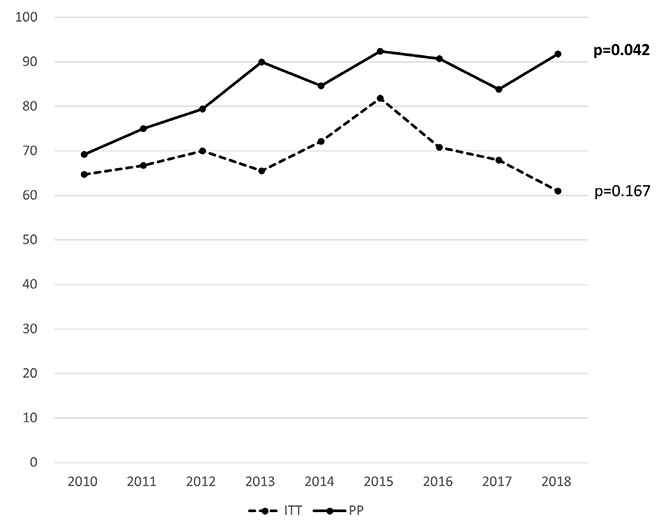Korean J Gastroenterol.
2019 Feb;73(2):99-104. 10.4166/kjg.2019.73.2.99.
Eradication Rates of 10-day Sequential Therapy for Helicobacter pylori: Results of an 8-year Prospective Study Conducted at a Tertiary Korean Hospital
- Affiliations
-
- 1Department of Internal Medicine, Seoul National University Bundang Hospital, Seongnam, Korea. nayoungkim49@empas.com
- 2Department of Internal Medicine, Wonkwang University Sanbon Hospital, Gunpo, Korea.
- 3Department of Internal Medicine and Liver Research Institute, Seoul National University College of Medicine, Seoul, Korea.
- KMID: 2438709
- DOI: http://doi.org/10.4166/kjg.2019.73.2.99
Abstract
- BACKGROUND/AIMS
The Helicobacter pylori (H. pylori) eradication rate of standard triple therapy is unsatisfactory in Korea, and sequential therapy (SQT) has been suggested to be a practical first-line alternative regimen. The aim of this prospective study was to document changes in annual eradication rates of SQT.
METHODS
A total of 983 H. pylori-positive subjects were enrolled from 2010 to 2018 and their data were subjected to intention-to-treat (ITT) and per-protocol (PP) analysis. All subjects received 10-day sequential therapy consisting of 40 mg esomeprazole and 1 g amoxicillin b.i.d for 5 days followed by 40 mg esomeprazole b.i.d, 500 mg clarithromycin b.i.d and 500 mg metronidazole t.i.d for 5 days. The 13C-urea breath test, rapid urease test (CLO test®), and histology were used to confirm eradication. Compliance and side effects were also investigated.
RESULTS
ITT and PP eradication rates of SQT were 69.9% (687 of 983) and 87.1% (657 of 754), respectively. The annual eradication rate of ITT remained consistent over the 8-year study period (p for trend=0.167), whereas PP analysis showed the eradication rate increased (p for trend=0.042). The overall adverse event rate for SQT was 41.7% (410 subjects).
CONCLUSIONS
Despite high antibiotic resistance rates in Korea, the eradication rate of SQT did not decrease over the 8-year study period.
MeSH Terms
Figure
Reference
-
1. McColl KE. Clinical practice. Helicobacter pylori infection. N Engl J Med. 2010; 362:1597–1604.2. Graham DY, Lew GM, Klein PD, et al. Effect of treatment of Helicobacter pylori infection on the long-term recurrence of gastric or duodenal ulcer. A randomized, controlled study. Ann Intern Med. 1992; 116:705–708.3. Bayerdörffer E, Neubauer A, Rudolph B, et al. Regression of primary gastric lymphoma of mucosa-associated lymphoid tissue type after cure of Helicobacter pylori infection. MALT lymphoma study group. Lancet. 1995; 345:1591–1594.4. Fukase K, Kato M, Kikuchi S, et al. Effect of eradication of Helicobacter pylori on incidence of metachronous gastric carcinoma after endoscopic resection of early gastric cancer: an open-label, randomised controlled trial. Lancet. 2008; 372:392–397.
Article5. Yoon K, Kim N. Reversibility of atrophic gastritis and intestinal metaplasia by eradication of Helicobacter pylori. Korean J Gastroenterol. 2018; 72:104–115.
Article6. Kim N, Kim J, Choe Y, et al. Diagnosis and treatment guidelines for Helicobacter pylori infection in Korea. Korean J Gastroenterol. 2009; 54:269–278.
Article7. Lee JY, Kim N, Kim MS, et al. Factors affecting first-line triple therapy of Helicobacter pylori including CYP2C19 genotype and antibiotic resistance. Dig Dis Sci. 2014; 59:1235–1243.
Article8. Oh HS, Lee DH, Seo JY, et al. Ten-day sequential therapy is more effective than proton pump inhibitor-based therapy in Korea: a prospective, randomized study. J Gastroenterol Hepatol. 2012; 27:504–509.
Article9. Wu DC, Hsu PI, Wu JY, et al. Sequential and concomitant therapy with four drugs is equally effective for eradication of H pylori infection. Clin Gastroenterol Hepatol. 2010; 8:36.e1–41.e1.
Article10. Boyanova L, Mitov I. Geographic map and evolution of primary Helicobacter pylori resistance to antibacterial agents. Expert Rev Anti Infect Ther. 2010; 8:59–70.11. Lee JY, Kim N. Future trends of Helicobacter pylori eradication therapy in Korea. Korean J Gastroenterol. 2014; 63:158–170.12. Sung J, Kim N, Park YH, et al. Rifabutin-based fourth and fifth-line rescue therapy in patients with for Helicobacter pylori eradication failure. Korean J Gastroenterol. 2017; 69:109–118.13. Mahachai V, Sirimontaporn N, Tumwasorn S, Thong-Ngam D, Vilaichone RK. Sequential therapy in clarithromycin-sensitive and -resistant Helicobacter pylori based on polymerase chain reaction molecular test. J Gastroenterol Hepatol. 2011; 26:825–828.
Article14. Scaccianoce G, Hassan C, Panarese A, Piglionica D, Morini S, Zullo A. Helicobacter pylori eradication with either 7-day or 10-day triple therapies, and with a 10-day sequential regimen. Can J Gastroenterol. 2006; 20:113–117.15. Zullo A, De Francesco V, Hassan C, Morini S, Vaira D. The sequential therapy regimen for Helicobacter pylori eradication: a pooled-data analysis. Gut. 2007; 56:1353–1357.
Article16. Yoon H, Lee DH, Kim N, et al. Meta-analysis: is sequential therapy superior to standard triple therapy for Helicobacter pylori infection in Asian adults? J Gastroenterol Hepatol. 2013; 28:1801–1809.
Article17. Lee JY, Kim N, Park KS, et al. Comparison of sequential therapy and amoxicillin/tetracycline containing bismuth quadruple therapy for the first-line eradication of Helicobacter pylori: a prospective, multi-center, randomized clinical trial. BMC Gastroenterol. 2016; 16:79.
Article18. Kim BJ, Kim HS, Song HJ, et al. Online registry for nationwide database of current trend of Helicobacter pylori eradication in Korea: interim analysis. J Korean Med Sci. 2016; 31:1246–1253.
Article19. Chung JW, Ha M, Yun SC, et al. Meta-analysis: sequential therapy is superior to conventional therapy for Helicobacter pylori infection in Korea. Korean J Gastroenterol. 2013; 62:267–271.
- Full Text Links
- Actions
-
Cited
- CITED
-
- Close
- Share
- Similar articles
-
- Eradication Rate of Helicobacter pylori According to the Diseases and Therapeutic Regimens, and Reinfection Rate after Successful Eradication in a Tertiary Clinic
- Ten-day Sequential Therapy versus Bismuth Based Quadruple Therapy as Second Line Treatment for Helicobacter pylori Infection
- Recent Trends of Helicobacter pylori Eradication Therapy: Focusing on First Line Treatment
- Effectiveness of 10 Day-sequential Therapy for Helicobacter pylori Eradication in Korea
- Approach to Patients after Successful Eradication of Helicobacter pylori



